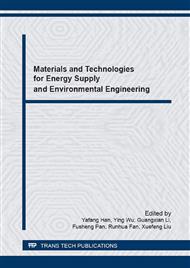[1]
B. Tong, Research on the application technology of GFRP tubing in oil well. Qingdao: Master degree thesis of China University of Petroleum. (2011).
Google Scholar
[2]
L.Z. Ma, X. H. Xie, Study on the extraction wells application of GFRP pipe production technology, Journal of Petroleum and Natural Gas. 32(2010) 369-372.
Google Scholar
[3]
Y. Meng, L.N. Xu, M.X. Lu, The use and evaluation of GFRP pipe in oil field, Corrosion and Protection. 33(2012) 664-667.
Google Scholar
[4]
G.A. Kashwani, A.K. Al-Tamimi, Evaluation of FRP bars performance under high temperature. Physics procedia, 55(2014) 296-300.
DOI: 10.1016/j.phpro.2014.07.043
Google Scholar
[5]
H.M. Feng, Y.F. Yang, Evaluation of corrosion resistance of FRP. FRP/Composite. 4(1999) 005.
Google Scholar
[6]
J.F. Liu et al, Material corrosion and control engineering. Peking University Press, Peking, (2010).
Google Scholar
[7]
J. RM. Almeida, R.C. De Almeida, W.R. De Lima, Effect of water absorption of the mechanical behavior of fiberglass pipes used for offshore service waters. Composite structures. 83(2008) 221-225.
DOI: 10.1016/j.compstruct.2007.04.020
Google Scholar
[8]
D.E. Mouzakis, H. Zoga, C. Galiotis. Accelerated environmental ageing study of polyester/glass fiber reinforced composites (GFRPCs). Composites Part B: Engineering. 39(2008) 467-475.
DOI: 10.1016/j.compositesb.2006.10.004
Google Scholar
[9]
G.Z. Liu, et al. Experimental study on corrosion mechanism and properties evolvement rule of FRP in salt spray environment. FRP/Composite. 1(2008) 35-40.
Google Scholar
[10]
N. Tarakcioglu, et al. The fatigue behavior of (±55) 3 filament wound GRP pipes with a surface crack under internal pressure. Composite Structures. 80(2007) 207-211.
DOI: 10.1016/j.compstruct.2006.05.015
Google Scholar
[11]
A. Hammami, N. Al-Ghuilani, Durability and environmental degradation of glass-vinylester composites. Polym Compos; 25(2004) 609.
DOI: 10.1002/pc.20055
Google Scholar
[12]
Avci, Ahmet, Ö.S. Şahin, N. Tarakçioğlu, Fatigue behavior of surface cracked filament wound pipes with high tangential strength in corrosive environment. Composites Part A: Applied Science and Manufacturing. 38(2007) 1192-1199.
DOI: 10.1016/j.compositesa.2006.04.011
Google Scholar
[13]
A. Stocchi, et al., Physical and water aging of glass fiber-reinforced plastic pipes. Composite Interfaces. 13(2006) 685-697.
DOI: 10.1163/156855406779366831
Google Scholar


